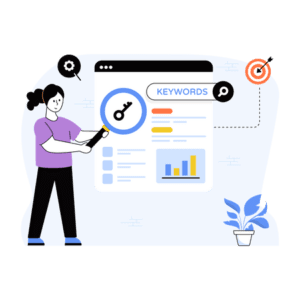5 Steps To Rank Higher On Google

Achieving a high ranking on Google is a common goal for businesses and website owners aiming to increase visibility and drive traffic. However, the journey to the top of search engine results is often shrouded in mystery, leaving many to wonder, “How long does it take to rank on Google?” The answer is complex, influenced by various factors such as keyword competitiveness, quality of content, and the overall SEO strategy. This article explores the typical timeline for ranking on Google and what you can expect during the process.
Keyword research and analysis are foundational steps in any successful SEO strategy. Here’s a detailed exploration of how to effectively develop and execute keyword research:
Understanding Keyword Research
Keyword research involves identifying and analyzing the search terms that users enter into search engines like Google when looking for information, products, or services. The goal is to discover keywords that are relevant to your business and have the potential to drive targeted traffic to your website.
Steps to Develop Keyword Research:
1. Define Your Goals and Objectives
Before diving into keyword research, clarify your business goals and objectives. Determine what you want to achieve with your SEO efforts, such as increasing website traffic, generating leads, or boosting sales.
2. Identify Your Target Audience
Understanding your target audience is crucial for effective keyword research. Consider factors such as demographics, interests, pain points, and search behavior. This insight helps you choose keywords that align with what your audience is searching for.
3. Brainstorm Seed Keywords
Start with broad, general terms related to your business or industry. These are known as seed keywords. For example, if you sell running shoes, your seed keywords might include “running shoes,” “athletic footwear,” or “sports shoes.”
4. Use Keyword Research Tools
Using keyword research tools is crucial for effective SEO strategy and improving your website’s visibility. These tools help identify valuable keywords that your target audience is searching for, enabling you to optimize your content to meet their needs and drive relevant traffic. Here’s how to leverage keyword research tools effectively:
Identify High-Value Keywords: Keyword research tools like Google Keyword Planner, SEMrush, Ahrefs, and Moz can help you find keywords with high search volume and low competition. By targeting these high-value keywords, you can increase your chances of ranking higher in search engine results and attracting more visitors.
Analyze Competitor Keywords: Many keyword research tools offer insights into the keywords your competitors are ranking for. Understanding their keyword strategy allows you to identify gaps and opportunities, helping you to target keywords that may be less competitive but still relevant to your audience.
Discover Long-Tail Keywords: Tools can also uncover long-tail keywords, which are longer, more specific search queries. These keywords often have lower competition and higher intent, making them valuable for capturing niche audiences and driving conversions.
Evaluate Keyword Difficulty: Assess the difficulty level of ranking for specific keywords using tools that provide a difficulty score. This helps you gauge whether it’s feasible to compete for those keywords based on your current domain authority and resources.
Track Keyword Performance: Keyword research tools often include tracking features that allow you to monitor the performance of your targeted keywords over time. By tracking rankings, traffic, and other metrics, you can adjust your strategy based on real-time data and trends.
Optimize Content Strategy: Use the insights gained from keyword research to inform your content creation strategy. Integrate relevant keywords naturally into your content, titles, headings, and meta descriptions to improve your search engine visibility and relevance to users.
Stay Updated on Trends: Keyword research tools can provide data on emerging trends and seasonal variations in search behavior. Staying informed about these trends allows you to adapt your content strategy and capitalize on new opportunities.
5. Analyze Keyword Metrics
Analyzing keyword metrics is essential for optimizing your SEO strategy and enhancing your website’s performance. Key metrics to focus on include:
Search Volume: This metric indicates how often a keyword is searched on search engines within a specific timeframe. Higher search volumes generally signal greater interest and potential traffic, but they may also come with higher competition. Balancing high-volume keywords with niche ones can help you target both broad and specific audience segments.
Keyword Difficulty: This score assesses how challenging it will be to rank for a particular keyword, considering factors like domain authority and existing competition. Lower difficulty scores suggest easier opportunities for ranking, while higher scores may require more robust SEO efforts and resources.
Click-Through Rate (CTR): CTR measures the percentage of users who click on your website’s link when it appears in search engine results for a specific keyword. A higher CTR indicates that your title tags and meta descriptions are compelling and relevant to search queries, driving more traffic to your site.
Cost Per Click (CPC): CPC reflects the average cost advertisers pay for each click on a keyword in paid search campaigns. Analyzing CPC can help gauge keyword competitiveness and profitability. High CPC values often correspond to high-value keywords with strong commercial intent.
Competitive Density: This metric shows the level of competition among advertisers bidding for a particular keyword. High competitive density suggests that many businesses are targeting the same keyword, which can influence your bidding strategy and content approach in paid search campaigns.
Search Intent: Understanding the search intent behind a keyword—whether informational, navigational, transactional, or commercial—helps tailor your content to meet user needs. Aligning your content with the search intent can improve relevance and engagement, leading to better SEO outcomes.
Trend Data: Analyzing keyword trends over time can reveal seasonal patterns, emerging topics, and shifts in user interests. Staying updated on these trends allows you to adjust your content and SEO strategies proactively to capitalize on current and future search behaviors.
6. Consider User Intent
Understand the intent behind each keyword. Users may be searching with informational intent (seeking information), navigational intent (looking for a specific website), or transactional intent (ready to make a purchase). Tailor your keyword strategy accordingly.
7. Competitor Analysis
Study your competitors’ keyword strategies to identify opportunities and gaps. Look at which keywords they are ranking for and prioritize keywords where you can compete effectively.
8. Organize and Prioritize Keywords
Organize your list of keywords into categories or themes based on relevance and search intent. Prioritize keywords that have a balance of decent search volume and manageable competition.
9. Create a Keyword Strategy
Develop a comprehensive keyword strategy that aligns with your content strategy, including where and how you will use your chosen keywords across your website.
10. Monitor and Adjust
Keyword research is an ongoing process. Regularly monitor keyword performance and make adjustments based on changes in search trends, user behavior, and your business goals.
Effective keyword research lays the groundwork for successful SEO campaigns. By understanding your audience, selecting the right keywords, and continually refining your strategy, you can improve your website’s visibility, attract targeted traffic, and achieve your business objectives.
2. Revenue Optimize on-page SEO
Optimizing on-page SEO for revenue involves strategically enhancing various elements of your website to improve search engine rankings, attract more relevant traffic, and ultimately boost conversions. Key tactics include:
Keyword Optimization: Research and integrate high-value keywords into key areas like title tags, meta descriptions, header tags, and throughout the content. This helps attract targeted visitors who are likely to engage with your products or services.
Compelling Content: Create high-quality, relevant content that addresses the needs and interests of your target audience. Engaging content not only attracts visitors but also encourages them to stay longer and explore more, increasing the likelihood of conversions.
User Experience (UX): Ensure your website is user-friendly with a clear, intuitive navigation structure, fast load times, and mobile responsiveness. A positive user experience can lead to higher engagement and reduced bounce rates, which are crucial for conversion optimization.
Call-to-Actions (CTAs): Place prominent and persuasive CTAs throughout your pages to guide visitors towards desired actions, such as making a purchase or signing up for a newsletter. Effective CTAs can significantly boost conversion rates and revenue.
Internal Linking: Use internal links to guide users to relevant pages and distribute link equity throughout your site. This not only improves SEO but also helps visitors discover additional content and products, increasing their likelihood of conversion.
Optimized Meta Tags: Write compelling meta titles and descriptions that include relevant keywords and clearly convey the value of your offerings. Well-crafted meta tags can improve click-through rates from search engine results pages, driving more qualified traffic.
Analytics and A/B Testing: Regularly monitor performance metrics and conduct A/B testing on key elements like headlines, CTAs, and layouts. Analyzing data helps identify what works best for your audience, allowing you to refine strategies and maximize revenue.
By focusing on these on-page SEO elements, you can enhance your website’s visibility, attract more qualified traffic, and improve overall conversion rates, ultimately leading to increased revenue.

3. Page Speed Optimization
Page speed optimization is essential for improving website performance, user experience, and search engine rankings. This process involves various strategies to reduce load times and enhance responsiveness.
Key techniques include optimizing images by compressing them to decrease file size without compromising quality, minimizing and combining CSS and JavaScript files to reduce the number of HTTP requests, and leveraging browser caching to store static resources locally on users’ devices for faster access. Additionally, using content delivery networks (CDNs) can distribute content across multiple servers globally, reducing latency and speeding up load times.
Implementing asynchronous loading for scripts and adopting a clean, efficient codebase further contribute to faster page speeds. Regularly testing and monitoring page performance with tools like Google PageSpeed Insights or GTmetrix helps identify areas for improvement and ensure that your website provides a fast, seamless experience for users.

4. Monitor and Analyze Performance
Monitoring and analyzing performance is vital for optimizing systems, whether they are websites, applications, or hardware. This process involves continuously tracking key performance indicators (KPIs) such as load times, response rates, and system uptime to assess the health and efficiency of the system.
Tools like Google Analytics, server monitoring software, and performance testing platforms can provide detailed insights into user behavior, system bottlenecks, and resource utilization.
Analyzing this data helps identify trends, diagnose issues, and make informed decisions about improvements or adjustments. Regular performance reviews ensure that systems operate smoothly, meet user expectations, and adapt to changing demands or potential problems, ultimately enhancing overall effectiveness and user satisfaction.
5. Secure Website (HTTPS)
A secure website, identified by “HTTPS” in the URL, indicates that the site uses Hypertext Transfer Protocol Secure to encrypt data transmitted between your browser and the website’s server.
This encryption is achieved through Secure Sockets Layer (SSL) or Transport Layer Security (TLS) protocols, which protect sensitive information, such as login credentials and personal details, from being intercepted by unauthorized parties.
HTTPS not only safeguards data integrity and confidentiality but also helps verify the authenticity of the website, ensuring that users are interacting with a legitimate site rather than a potentially malicious one. The presence of a padlock icon in the address bar further signals that the connection is secure. For users, always ensuring that a website uses HTTPS before entering any sensitive information is crucial for maintaining online security and privacy.






Post Comment